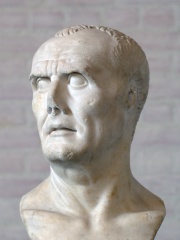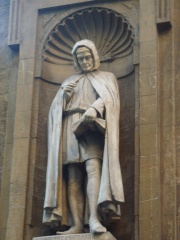



The Most Famous
DIPLOMATS from Italy
Top 5
The following people are considered by Pantheon to be the most legendary Italian Diplomats of all time. This list of famous Italian Diplomats is sorted by HPI (Historical Popularity Index), a metric that aggregates information on a biography's online popularity.

1. Gaius Marius (157 BC - 86 BC)
With an HPI of 78.88, Gaius Marius is the most famous Italian Diplomat. His biography has been translated into 64 different languages on wikipedia.
Gaius Marius (Latin: [ˈɡaːiʊs ˈmariʊs]; c. 157 BC – 13 January 86 BC) was a Roman general and statesman. Victor of the Cimbric and Jugurthine wars, he held the office of consul an unprecedented seven times. Rising from a family of smallholders in a village called Ceraetae in the district of Arpinum, Marius acquired his initial military experience serving with Scipio Aemilianus at the Siege of Numantia in 134 BC. He won election as tribune of the plebs in 119 BC and passed a law limiting aristocratic interference in elections. Barely elected praetor in 115 BC, he next became the governor of Further Spain where he campaigned against bandits. Marius attained his first consulship in 107 BC and became the commander of Roman forces in Numidia, where he brought an end to the Jugurthine War. By 105 BC Rome faced an invasion by the Cimbri and Teutones, and the comitia centuriata elected Marius consul for a second time to face this new threat. Marius was consul every year from 104 to 100 BC, and he defeated the Teutones at Aquae Sextiae and the Cimbri at Vercellae. However, Marius suffered political setbacks during his sixth consulship in 100 BC and afterwards entered a period of semi-retirement from public life. The Republic fell into crisis with the outbreak of the Social War in 91 BC, in which Marius fought with limited success. He then became embroiled in a conflict with the Roman general Sulla which resulted in his exile to Africa in 88 BC. Marius returned to Italy from Carthage during the War of Octavius, seized Rome, and began a bloody reign of terror in the city which culminated in his election as consul a seventh time and then dying within weeks of assuming this seventh consulship, in 86 BC. In the 19th century, Marius was credited with the so-called Marian reforms, including the shift from militia levies to a professional soldiery; improvements to the pilum (a kind of javelin); and changes to the logistical structure of the Roman army. Twenty-first-century historians generally view the notion as "a construct of modern scholarship."

2. Giovanni Villani (1276 - 1348)
With an HPI of 66.38, Giovanni Villani is the 2nd most famous Italian Diplomat. His biography has been translated into 25 different languages.
Giovanni Villani (Italian pronunciation: [dʒoˈvanni vilˈlaːni]; c. 1276 or 1280 – 1348) was an Italian banker, official, diplomat and chronicler from Florence who wrote the Nuova Cronica (New Chronicles) on the history of Florence. He was a leading statesman of Florence but later gained an unsavoury reputation and served time in prison as a result of the bankruptcy of a trading and banking company he worked for. His interest in and elaboration of economic details, statistical information, and political and psychological insight mark him as a more modern chronicler of late medieval Europe. His Cronica is viewed as the first introduction of statistics as a positive element in history. However, historian Kenneth R. Bartlett notes that, in contrast to his Renaissance-era successors, "his reliance on such elements as divine providence links Villani closely with the medieval vernacular chronicle tradition." In recurring themes made implicit through significant events described in his Cronica, Villani also emphasized three assumptions about the relationship of sin and morality to historical events, these being that excess brings disaster, that forces of right and wrong are in constant struggle, and that events are directly influenced by the will of God. Villani was inspired to write his Cronica after attending the jubilee celebration in Rome in 1300 and noting the venerable history of that city. He outlined the events in his Cronica year for year, following a strictly linear narrative format. He provided intricate details on many important historical events of the city of Florence and the wider region of Tuscany, such as construction projects, floods, fires, famines, and plagues. While continuing work on the Cronica and detailing the enormous loss of life during the Black Death in 1348, Villani died of the same illness. His work on the Cronica was continued by his brother and nephew. Villani's work has received both praise and criticism from modern historians. The criticism is mostly aimed at his emphasis on supernatural guidance of events, his organizational style, and his glorification of the papacy and Florence.

3. Ambrogio Contarini (1429 - 1499)
With an HPI of 60.09, Ambrogio Contarini is the 3rd most famous Italian Diplomat. His biography has been translated into 16 different languages.
Ambrogio Contarini (1429–1499) was a Venetian nobleman, merchant and diplomat known for an account of his travel to Iran, where he met Giosafat Barbaro.

4. Filippo Grandi (b. 1957)
With an HPI of 57.17, Filippo Grandi is the 4th most famous Italian Diplomat. His biography has been translated into 22 different languages.
Filippo Grandi (born 30 March 1957) is an Italian diplomat and United Nations official, currently serving as United Nations High Commissioner for Refugees. He previously served as Commissioner-General of the United Nations Relief and Works Agency for Palestine Refugees in the Near East (UNRWA) and United Nations Deputy Special Representative for Afghanistan. He received the Olympic Laureate award during the Paris 2024 Olympics Opening Ceremony.

5. Alessandro Minuto-Rizzo (b. 1940)
With an HPI of 54.23, Alessandro Minuto-Rizzo is the 5th most famous Italian Diplomat. His biography has been translated into 17 different languages.
Alessandro Minuto-Rizzo (born 10 September 1940) is an Italian diplomat who served as Deputy Secretary General of NATO from 2001 to 2007, and as acting Secretary General of NATO from 17 December 2003 to 1 January 2004, in between the tenures of The Lord Robertson of Port Ellen and Jaap de Hoop Scheffer. Prior to being appointed Deputy Secretary General, he served as ambassador of Italy to the Western European Union and to the Committee for Policy and Security of the European Union. He is a member of the Italy-USA Foundation.
People
Pantheon has 5 people classified as Italian diplomats born between 157 BC and 1957. Of these 5, 2 (40.00%) of them are still alive today. The most famous living Italian diplomats include Filippo Grandi, and Alessandro Minuto-Rizzo. The most famous deceased Italian diplomats include Gaius Marius, Giovanni Villani, and Ambrogio Contarini.
Living Italian Diplomats
Go to all RankingsDeceased Italian Diplomats
Go to all RankingsGaius Marius
157 BC - 86 BC
HPI: 78.88
Giovanni Villani
1276 - 1348
HPI: 66.38
Ambrogio Contarini
1429 - 1499
HPI: 60.09

